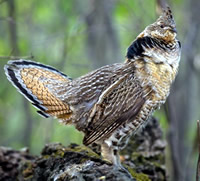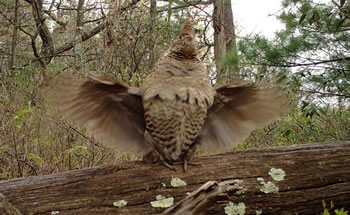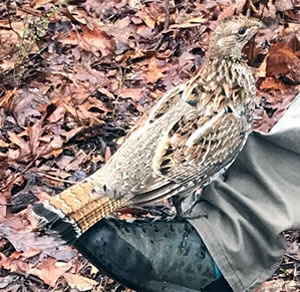  |
Ruffed Grouse Ecology |
|
by
Joseph R. Garris, Wildlife Technician
Upland Game & Furbearer Research Project
August, 2020
The ruffed grouse (Bonasa umbellus) is the most widely distributed member of the Pheasant Family native to the North American continent, and is found in every Canadian province and at least 33 US states. It is often found in conjunction with aspen-birch-conifer forests in the northern portion of its range, but also in the mixed oak-hickory-beech-cherry hardwood forests of the Appalachian Mountains in the eastern United States.
Young age forest stands are important for both cover and food, and grouse populations are highest in areas where logging, burning, and other disturbance create openings in older forest stands. Other species, including American woodcock and golden-winged warbler, have similar habitat requirements for their survival. Unfortunately, Young Forest habitats are in short supply and are often not in close proximity relative to each other - in fact 5% of New Jersey's two million acres of forests are less than 20 years of age. Targeted, scientific forest management practices are critical to recover grouse populations in New Jersey.
|

Photo Courtesy of Gerard W. Beyersbergen
Click to enlarge
|
Adult grouse weigh about 1.5 pounds and have a body length of about 15 to 19 inches with a wingspread of from 22 to 25 inches (males are slightly larger than females). The typical plumage is rich brown sprinkled with white and black above, and white with horizontal dark brown bars on the breast and undersides. The tail is mostly brown, and is finely barred with black and has a wide, black band near the outer edge. The ruff, from which the bird gets its name, is a ring of iridescent black feathers that almost completely encircle the male's neck. Two color phases (types) can occur: gray, and the more common typical red-brown. An adult grouse can fly at about 20 mph, although its thunderous burst makes it appear even faster.

Drumming to attract a mate
Photo Courtesy of John Parke, NJAS
Click to enlarge
|
In early spring the male grouse will seek a log on which to begin the mating ritual known as drumming to attract a mate. This drumming is a sound made by the male grouse beating his wings against the air to create a sound which is similar to someone starting a small gasoline engine. Courtship is short, only taking a few minutes and once mated, the female grouse selects a secluded nest site, usually under brush or at the base of a tree. There she will lay from six to 16 eggs in a leaf-lined depression on the ground.
Following an incubation period of about 24 days, the chicks will leave the nest as soon as they are dry. The precocious chicks are capable of feeding themselves immediately, begin to fly within a week, and can fly well by three weeks of age.
|
Grouse chicks require large amounts of animal protein for the first few weeks of life. Small forest openings provide abundant insects and cover for feeding chicks. Chicks grow rapidly, increasing quickly from about ½ ounce at hatching to near adult weight four months later. Their diet will gradually shift to green plant materials and fruits as they become older. Adult grouse eat many types of food depending of the season. They consume protein-rich insects, blackberries, blueberries and other wild fruits during summer, and both hard- and soft-mast fruits (acorns, beechnuts, cherries, barberries, wild grapes, apples, dogwood fruits) along with various buds and leaves during autumn. Buds, especially those of aspen, birch, beech, maple, cherry and apple, are the grouse's primary winter diet. Ferns, green leaves and other evergreen foods are eaten until food becomes more available in the spring.
Predation and disease are the primary mortality factors. Skunks, raccoons and crows are known nest predators while fox, coyote and bobcat consume both chicks and adult grouse. Raptors such as Cooper's hawk, goshawk and great horned owl are probably the most efficient grouse predators. Recent research in Pennsylvania and elsewhere in the Northeast indicate that West Nile Virus may be an important mortality factor, depending on the age birds are infected.
|
Many grouse hunters will tell of how wary the bird is and how the abrupt, thunderous sound of the flushing bird unnerves them! Approaching the amazingly camouflaged grouse is difficult even with a well-trained pointing dog. Always, the hunter expects to be surprised when the bird flushes.
The ruffed grouse that we know is anything but tame. Occasionally however, one might hear of a "tame" grouse that approaches humans and even lets a human touch them or pick them up. Or, one might hear of a grouse that follows a person or a vehicle and will repeatedly fly at or after that person or vehicle like it's attacking. This phenomenon is actually what might be called hyper-territorial behavior and usually occurs in late winter/early spring.
The grouse in question is always an adult male and is aggressively protecting his territory from what he perceives as an intruder. That site at which he is acting so oddly is actually close to his core area and drumming log. This phenomenon will only last for a few weeks or until breeding season is underway. It is unusual grouse that exhibits this behavior, but it does happen occasionally. (For a video of such a phenomenon, see the article about a NY hunter's experience.)
MORE INFORMATION
Grouse Season Closure Announced
Ruffed Grouse in New Jersey
Ruffed Grouse Society
Disturbed Forest - The Forsaken Science of Healthy Forests (Ruffed Grouse Society Video)
|

The ruffed grouse is normally one of the wariest of game birds
Photo Courtesy of Jonathan Van DeVenter
Click to enlarge
|
|



